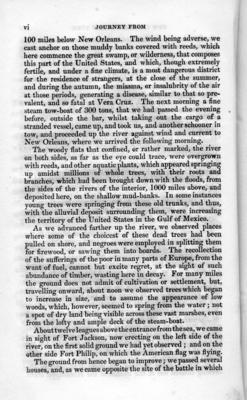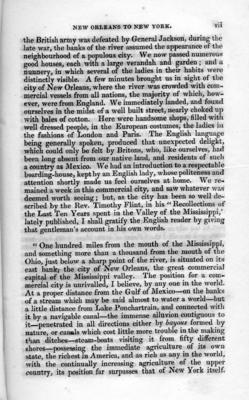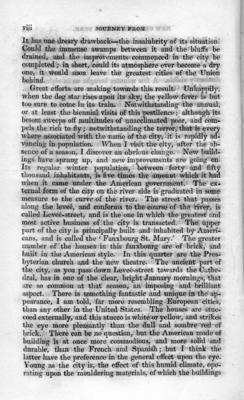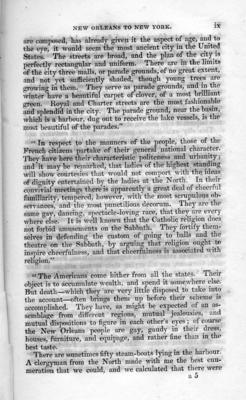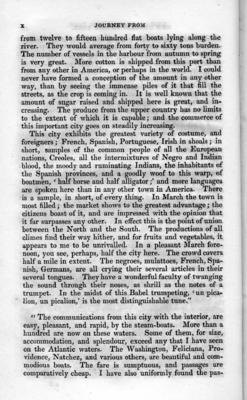Pages
Page 6
vi JOURNEY FROM
100 miles below New Orleans. The wind being adverse, we cast anchor on those muddy banks covered with reeds, which here commence the great swamp, or wilderness, that composes this part of the United States, and which, though extremely fertile, and under a fine climate, is a most dangerous district for the residence of strangers, at the close of the summer, and during the autumn, the miasma, or insalubrity of the air at those periods, generating a disease, similar to that so prevalent, and so fatal at Vera Cruz. The next morning a fine steam tow-boat of 300 tons, that we had passed the evening before, outside the bar, whilst taking out the cargo of a stranded vessel, came up, and took us, and another schooner in tow, and proceeded up the river against wind and current to New Orleans, where we arrived the following morning.
The woody flats that confined, or rather marked, the river on both sides, as far as the eye could trace, were overgrown with reeds, and other aquatic plants, which appeared springing up amidst millions of whole trees, with their roots and branches, which had been brought down with the floods, from the sides of the rivers of the interior, 1000 miles above, and deposited here, on the shallow mud-banks. In some instances young trees were springing from these old trunks, and thus, with the alluvial deposit surrounding them, were increasing the territory of the United States in the Gulf of Mexico.
As we advanced farther up the river, we observed places where some of the choicest of these dead trees had been pulled on shore and negroes were employed in splitting them for firewood, or sawing them into boards. The recollection of the sufferings of the poor in many parts of Europe, from the want of fuel, cannot but excite regret, at the sight of such abundance of timber, wasting here in decay. For many miles the ground does not admit of cultivation or settlement, but, travelling onward, about noon we observed trees which began to increase in size, and to assume the appearance of low woods, which, however, seemed to spring from the water ; not a spot of dry land being visible across these vast marshes, even from the lofty and ample deck of the steam-boat.
About twelve leagues above the entrance from the sea, we cam in sight of Fort Jackson, now erecting on the left side of the river, on the first solid ground we had yet observed ; and on the other side Fort Philip, on which the American flag was flying.
The ground from hence began to improve ; we passed several houses, and, as we came opposite the site of the battle in which
Page 7
NEW ORLEANS TO NEW YORK. vii
the British army was defeated by General Jackson, during the late war, the banks of the river assumed the appearance of the neighbourhood of a populous city. We now passed numerous good houses, each with a large verandah and garden; and a nunnery, in which several of the ladies in their habitats were distinctly visible. A few minutes brought us in sight of the city of New Orleans, where the river was crowded with commercial vessels from all nations, the majority of which, however were from England. We immediately landed, and found ourselves in the midst of a well built street, nearly choked up with bales of cotton. Here were handsome shops, filled with well dressed people, in the European costumes, the ladies in the fashipns of London and Paris. The English Language being generally spoken, produced that unexpected delight, which could only be felt by Britons, who, like ourselves, had been long absent from our native land, and residents of such a country as Mexico. We has an introduction to a respectable boarding-house, kept by an English lady, whose politeness and attention shortly made us feel ourselves at home. We remained a week in this commercial city, and saw whatever was deemed worth seeing ; but, as the city has been so well described by the Rev. Timothy Flint, in his "Recollections of the Last Ten Years spent in the Valley of the Mississippi,' lately published, I shall gratify the English reader by giving that gentleman's account in his own words.
"One hundred miles from the mout of the Mississippi, and something more than a thousand from the mouth of the Ohio, just below a sharp point of the river, is situated on its east bank, the city of New Orleans, the great commercial capital of the Mississippi valley. The position for a commercial city is unrivalled, I believe, by any one in the world. At a proper distance from the Gulf of Mexico–on the banks of a stream which may be said almost to water a world–but a little distance from Lake Ponchartrain, and connected with it by a navigable canal–the immense alluvion contiguous to it–penetrated in all directions either by bayous formed by nature, or canals which cost little more trouble in the making than ditches–steam-boats visiting it from fifty different shores–possessing the immediate agriculture of its own state, the richest in America, and as rich as any in the world, with continually increasing agriculture of the upper country, its position far surpasses that of New York itself.
Page 8
viii JOURNEY FROM It has one dreary drawback–the insalubrity of its situation. Could the immense swamps between it and the bluffs be drained, and the improvements commenced in the city be completed; in short, could its atmospher ever become a dry one, it would soon leave the greatest cities of the Union behind.
Great efforts are making towards this result. Unhappily, when the dog star rises upon its sky, the yellow fever is but too sure to come in its train. Notwithstanding the annual, or at least the biennial visits of this pestilence ; although its besom sweeps off multitudes of unacclimated poor, and compels the rich to fly ; notwithstanding the terror, that is every where associated with the name of the city, after the absence of a season, I discover an obvious change. New buildings have sprung up, and new improvements are going on. Its regular winter population, between forty and fifty thousand inhabitants, is five times the amount which it had when it came under the American government. The external form of the city on the river side is graduated in some measure to the curve of the river. The street that passes along the leveé, and conforms to the course of the river, is called Leveé-street, and is the one in which the greatest and most active business of the city is transacted. The upper part of the city is principally built and inhabited by Americans, and is called the 'Fauxbourg St. Mary.' The greater number of the houses in this fauxbourg are of brick, and built in the American style. In this quarter are the Presbyterian church and the new theatre. The ancient part of the city, as you pass down Leveé-street towards the Cathedral, has in one of the clear, bright January mornings, that are so common at that season, an imposing and brilliant aspect. There is something fantastic and unique in the appearance, I am told, far more resembling European cities, than any other in the United States. The houses are stuccoed externally, and this stucco is white or yellow, and strikes the eye more pleasantly than the dull and sombre red of brick. There can be no question, but the American mode of building is at once more commodius, and more solid and durable, than the French and Spanish ; but I think the latter have the preference in the general effect upon the eye. Young as the city is, the effect of this humid climate, operating upon the mouldering materials, of which the buildings
Page 9
NEW ORLEANS TO NEW YORK. ix
are composed, has already given it the aspect of age, and to the eye, it would seem the most ancient city in the United States. The streets are broad, and the plan of the city is perfectly rectangular and uniform. There are in the limits of the city three malls, or parade grounds, of no great extent, and not yet sufficiently shaded, though young trees are growing in them. They serve as parade grounds, and in the winter have a beautiful carpet of clover, of a most brilliant green. Royal and Charter streets are the most fashionable and splendid in the city. The parade ground, near the basin, which is a harbour, dug out to receive the lake vessels, is the most beautiful of the parades."
"In respect to the manners of the people, those of the French citizens partake of their general national character. They have here their characteristic politeness and urbanity ; and it may be remarked, that ladies of the highest standing will show courtesies that would not comport with the ideas of dignity entertained by the ladies at the North. In their convivial meetings there is apparently a great deal of cheerful familiarity, tempered, however, with the most scrupulous observances, and the most punctilious decorum. They are the same gay, dancing, spectacle-loving race, that they are every where else. It is well known that the Catholic religion does not forbid amusements on the Sabbath. They fortify themselves in defending the custom of going to balls and the theatre on the Sabbath, by arguing that religion ought to inspire cheefulness, and that cheerfulness is associated with religion."
"The Americans come hither from all the states. Their object is to accumulate wealth, and spend it somewhere else. But death–which they are very little disposed to take into the account–often brings them up before their scheme is accomplished. They have, as might be expected of an assemblage from different regions, mutual jealousies, and mutual dispositions to figure in each other's eyes ; of course the New Orleans people are gay, gaudy in their dress, houses, furniture, and equipage, and rather fine than in the best taste.
There are some fifty steam-boats lying in the harbour. A clergyman from the North made with me the best enumeration that we could, and we calculated that there were
a 5
Page 10
x JOURNEY FROM
from twelve to fifteen hundred flat boats lying along the river. They would average from forty to sixty tons burden. The number of vessels in the harbour from autumn to spring is very great. More cotton is shipped from this port than from any other in America, or perhaps the world. I could never have formed a conception of the amount in any other way, than by seeing the immense piles of it that fill the streets, as the crop is coming in. It is well known that the amount of sugar raised and shipped here is great, and increasing. The produce from the upper country has no limits to the extent of which it is capable ; and the commerce of this important city goes on steadily increasing.
This city exhibits the greatest variety of costume, and foreigners ; French, Spanish, Portugese, Irish in shoals ; in short, samples of the common people of all the European nations, Creoles, all the intermixtures of Negro and Indian blood, the moody and ruminating Indians, the inhabitants of the Spanish provinces, and a goodly woof to this warp, of boatment, 'half horse and half alligator ;' and more languages are spoken here than in any other town in America. There is a sample, in short, of every thing. In March the town is most filled ; the market shows to the greatest advantage ; the citizens boast of it, and are impressed with the opinion that it far surpasses any other. In effect this is the point of union between the North and the South. The productions of all climes find their way hither, and for fruits and vegetables, it appears to me to be unrivalled. In a pleasant March forenoon, you see, perhaps, half the city here. The crowd covers half a mile in extent. The negroes, mulattoes, French, Spanish, Germans, are all crying their several articles in their several tongues. They have a wonderful faculty of twanging the sound through their noses, as shrill as the notes of a trumpet. In the midst of the Babel trumpeting, 'un picalion, un picalion,' is the most distinguishable tune."
"The communications from this city with the interior, are easy, pleasant, and rapid, by the steam-boats. More than a hundred are now on these waters. Some of them, for size, accomodation, and splendour, exceed any that I have seen on the Atlantic waters. The Washington, Feliciana, Providence, Natchez, and various others, are beautiful and commodious boats. The fare is sumptuous, and passages are comparatively cheap. I have also uniformly found the pas-
